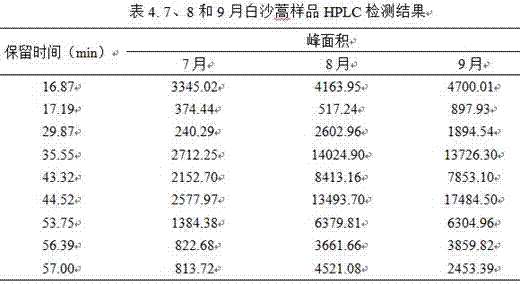Method for detection of flavonoids in Artemisia baicalensis by high performance liquid chromatography
A technique of high performance liquid chromatography and Artemisia annua, applied in the field of detecting flavonoid components of Artemisia annua by high performance liquid chromatography, can solve problems such as no report on the detection method of Artemisia annua Handling simple effects
- Summary
- Abstract
- Description
- Claims
- Application Information
AI Technical Summary
Problems solved by technology
Method used
Image
Examples
example 1
[0030] Example 1. Detection of flavonoids in Artemisia annua growing in semi-mobile sand dunes
[0031] Test sample treatment: Collect fresh plant samples of Artemisia annua growing in semi-mobile sand dunes, dry in the shade, crush and pass through a 100-mesh sieve. Weigh 0.20 g of the sample, dissolve it in 20 mL of ethanol, and extract it ultrasonically for 30 min; take 1.25 mL in a 1.5 mL centrifuge tube, centrifuge for 5 min, and filter the supernatant through a microporous membrane (0.45 μm) to obtain liquid.
[0032] Liquid chromatographic conditions: Agilent-1100 high performance liquid chromatograph; GraceSmart RP18 reverse-phase chromatographic column (4.6mm×250mm, 5 μm). Mobile phase: 0.2% by mass acetic acid water (phase A) and methanol (phase B), the total flow rate is 0.6mL / min, and the detection wavelength is 275nm.
[0033] The volume ratio, detection sequence and retention time of the mobile phase: in order:
[0034] 0-5 min, the volume ratio of component B...
Embodiment 2
[0043] Example 2. Detection of flavonoids in Artemisia annua growing in the semi-arid Loess Plateau
[0044] Test sample treatment: Collect fresh plant samples of Artemisia annua growing in the semi-arid Loess Plateau, dry in the shade, crush and pass through a 100-mesh sieve. Weigh 0.20 g of the sample, dissolve it in 20 mL of ethanol, and extract it ultrasonically for 30 min; take 1.25 mL in a 1.5 mL centrifuge tube, centrifuge for 5 min, and filter the supernatant through a microporous membrane (0.45 μm) to obtain liquid.
[0045] Liquid chromatographic conditions: Agilent-1100 high performance liquid chromatograph; GraceSmart RP18 reverse-phase chromatographic column (4.6mm×250mm, 5 μm). Mobile phase: 0.2% by mass acetic acid water (phase A) and methanol (phase B), the total flow rate is 0.6mL / min, and the detection wavelength is 275nm.
[0046] Chromatographic method is with example 1.
[0047] Test results: See Table 3 for the flavonoid components of Artemisia annua g...
Embodiment 3
[0050] Example 3. Detection of flavonoids in different periods of Artemisia annua growing in a semi-mobile sand dune environment
[0051]Test sample treatment: Collect fresh plant samples of Artemisia baicalensis in different periods (July, August and September) in the environment of semi-mobile sand dunes, dry them in the shade, crush them and pass them through a 100-mesh sieve. Weigh 0.20 g of the sample, dissolve it in 20 mL of ethanol, and extract it ultrasonically for 30 min; take 1.25 mL in a 1.5 mL centrifuge tube, centrifuge for 5 min, and filter the supernatant through a microporous membrane (0.45 μm) to be the test solution .
[0052] Liquid chromatographic conditions: Agilent-1100 high performance liquid chromatograph; GraceSmart RP18 reverse-phase chromatographic column (4.6mm×250mm, 5 μm). Mobile phase: 0.2% by mass acetic acid water (phase A) and methanol (phase B), the total flow rate is 0.6mL / min, and the detection wavelength is 275nm.
[0053] Chromatographi...
PUM
 Login to View More
Login to View More Abstract
Description
Claims
Application Information
 Login to View More
Login to View More - R&D
- Intellectual Property
- Life Sciences
- Materials
- Tech Scout
- Unparalleled Data Quality
- Higher Quality Content
- 60% Fewer Hallucinations
Browse by: Latest US Patents, China's latest patents, Technical Efficacy Thesaurus, Application Domain, Technology Topic, Popular Technical Reports.
© 2025 PatSnap. All rights reserved.Legal|Privacy policy|Modern Slavery Act Transparency Statement|Sitemap|About US| Contact US: help@patsnap.com



